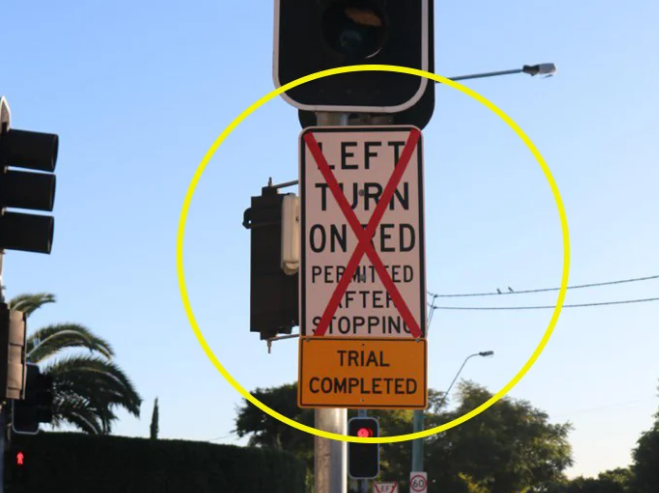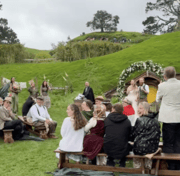
With Brisbane now crowned Australia's most congested city, where drivers waste 74 hours annually stuck in traffic, there's renewed momentum behind a controversial road rule that many thought was gone for good.
The 'left turn on red' rule, which allows motorists to turn left at specific intersections after coming to a complete stop—even when facing a red light—is making headlines again as Brisbane Lord Mayor Adrian Schrinner pushes for its return.
For Brisbane's growing population of over 2.5 million residents, including many seniors who remember when city traffic moved more freely, this could be a welcome relief from increasingly frustrating daily commutes.
A rule with history
The left turn on red provision isn't entirely foreign to Australian roads. Currently, signs permitting left turns on red exist in limited locations in New South Wales, South Australia, Northern Territory and Australian Capital Territory, though they're strictly banned in other states.
In fact, South Australia currently has 7 intersections where left turn on red is permitted, with 12 more locations set to be introduced, showing the rule can work successfully when properly implemented.
Brisbane's own experience ran from 2013 to 2021, expanding to nearly 50 intersections at its peak before being scrapped by the former state government over safety concerns.
'People loved it, 85 per cent of people we talked to said it was a great thing'
Why the urgency now?
Brisbane now ranks as Australia's most congested city, with drivers losing 74 hours yearly to traffic. This represents a significant shift—Brisbane has overtaken traditional traffic nightmares like Sydney and Melbourne.
The numbers tell the story of a city straining under rapid growth. Brisbane has grown by 31,720 people in the last year alone, representing a 1.25 per cent annual change, while infrastructure development has not kept pace with population growth, adding to congestion woes.
For seniors on fixed incomes, the rising costs of fuel and time spent idling in traffic represent a double burden. Every minute saved through improved traffic flow translates to real savings at the bowser and less stress behind the wheel.
The safety question
The rule's previous cancellation wasn't without reason. Queensland's trial period found that safety risks to pedestrians outweighed time-saving benefits, leading to its removal in 2021.
The RACQ maintains its cautious stance, with head of public policy Michael Kane arguing the rule can 'add confusion' and advocating for alternatives like 'dedicated turn lanes, green arrows and slip lanes' as better long-term solutions.
However, Mayor Schrinner disputes the safety narrative, claiming there were 'only two accidents attributed to the trial and neither involved a pedestrian or a cyclist' during the eight-year period.
Where left turn on red currently works in Australia
South Australia: 7 active intersections, expanding to 19
New South Wales: Limited locations meeting strict criteria
Northern Territory: Select intersections with appropriate signage
Australian Capital Territory: Specific permitted locations
Queensland: Banned since 2021
Victoria, Western Australia, Tasmania: Not permitted
What this means for older drivers
For seniors, the left turn on red rule offers both opportunities and considerations. On the positive side, it can reduce waiting times at intersections, particularly during off-peak hours when many older drivers prefer to travel.
The rule requires complete stops and careful observation—driving practices that many experienced drivers already employ. The rule allows drivers to turn left at specific intersections after stopping fully and checking for safety, which aligns with defensive driving techniques.
However, it does require additional awareness of intersection-specific signage and road rules that vary by location, which could initially be confusing for some drivers.
Learning from interstate success
South Australia's 'Turn Left on Red Permitted After Stopping' rule allows drivers to turn left at specific intersections, even when facing a red light, as long as they stop fully and check for safety. Their systematic approach to implementation and expansion suggests the rule can work safely when properly managed.
The key difference appears to be in implementation strategy. Rather than rolling out broadly, SA has taken a measured approach, starting with 7 intersections and carefully expanding based on results.
What seniors need to know about left turn on red
- Only applies where specifically signposted
- Requires a complete stop first
- Must give way to all pedestrians, cyclists and traffic
- Currently operates successfully in SA, NSW, NT and ACT
- Still under review for Queensland's return
Political momentum building
Current Queensland Transport Minister Brent Mickelberg has indicated openness to reconsidering the rule, stating the government is 'seeking advice from the department on how it could be rolled out and what needs to be considered.'
This represents a shift from the previous government's position and suggests political appetite for traffic solutions that match Brisbane's growing infrastructure challenges.
The Brisbane City Council has formally written to the state government requesting the rule's reinstatement, indicating this isn't just mayoral grandstanding but a considered policy position.
The bigger picture
Brisbane's traffic woes extend beyond any single rule change. The Brisbane Metro, set to launch in late 2024, aims to revolutionise public transport with high-capacity electric services integrating with existing bus networks.
Additional projects including Gateway Motorway upgrades and the Coomera Connector are also in planning, but these projects may not be sufficient to fully address growing traffic issues, requiring continued investment in both road infrastructure and public transport.
For a city experiencing rapid growth, every efficiency measure matters. While left turn on red isn't a silver bullet for Brisbane's congestion crisis, it could provide marginal improvements that add up to meaningful time savings for daily commuters.
Did you know?
Did you know?
Brisbane has the third-largest high-density area in Australia at 24 km², behind only Sydney (194 km²) and Melbourne (69 km²), contributing to its congestion challenges.
What happens next
The rule's return will ultimately depend on the Queensland government's review process and their assessment of updated safety protocols. Given the successful implementation in other Australian jurisdictions and the mounting pressure from Brisbane's congestion crisis, there appears to be genuine momentum for change.
For Brisbane drivers, particularly seniors who value efficient travel during off-peak hours, this represents a potential return to more flexible intersection management that could ease daily frustrations.
The debate reflects broader questions about balancing traffic efficiency with pedestrian safety—considerations that become increasingly important as our cities grow denser and our populations age.
What are your thoughts on bringing back the left turn on red rule? Have you experienced this type of intersection management in other states, and do you think the benefits outweigh the safety concerns for Brisbane's growing traffic challenges?
Original Article
https://au.news.yahoo.com/big-push-...for-millions-of-aussie-drivers-221840942.html
Turn on red—Wikipedia
Cited text: Such signs are only in limited locations in the states of New South Wales, South Australia, Northern Territory and Australian Capital Territory and ar...
Excerpt: Currently, signs permitting left turns on red exist in limited locations in New South Wales, South Australia, Northern Territory and Australian Capital Territory, though they're strictly banned in other states
https://en.wikipedia.org/wiki/Turn_on_red
Can I turn left on a red light? | samotor The RAA Magazine
Cited text: Currently, there are only 7 intersections across the state where you’re allowed to turn left on a red light, but 12 more locations will soon be introd...
Excerpt: South Australia currently has 7 intersections where left turn on red is permitted, with 12 more locations set to be introduced
https://samove.raa.com.au/redlight/
Brisbane Tops Australia for Worst Traffic Congestion in 2023 | Smith's Lawyers
Cited text: Brisbane now ranks as Australia's most congested city, with drivers losing 74 hours yearly to traffic.
Excerpt: Brisbane now ranks as Australia's most congested city, with drivers losing 74 hours yearly to traffic
https://www.smithslawyers.com.au/post/brisbane-traffic-getting-worse
Brisbane Population 2025
Cited text: Brisbane has grown by 31,720 in the last year, which represents a 1.25 per cent annual change.These population estimates and projections come from the latest ...
Excerpt: Brisbane has grown by 31,720 people in the last year alone, representing a 1.25 per cent annual change
https://worldpopulationreview.com/cities/australia/brisbane
Brisbane Tops Australia for Worst Traffic Congestion in 2023 | Smith's Lawyers
Cited text: Infrastructure Lag: While there have been some improvements, infrastructure development has not kept pace with population growth. Therefore, this dela...
Excerpt: infrastructure development has not kept pace with population growth, adding to congestion woes
https://www.smithslawyers.com.au/post/brisbane-traffic-getting-worse
Turn on red—Wikipedia
Cited text: Queensland previously allowed left turns on red at certain intersections, but was scrapped in 2021 after a trial period found that the safety risk to ...
Excerpt: Queensland's trial period found that safety risks to pedestrians outweighed time-saving benefits
https://en.wikipedia.org/wiki/Turn_on_red
Turning Left on Red in South Australia: A Guide for Learner Drivers and Overseas Visitors—OSquare Driving School
Cited text: In South Australia, the “Turn Left on Red Permitted After Stopping” (LTOR) rule allows drivers to turn left at specific intersections, even when facin...
Excerpt: The rule allows drivers to turn left at specific intersections after stopping fully and checking for safety
https://osquaredrivingschool.com.au...de-for-learner-drivers-and-overseas-visitors/
Brisbane Tops Australia for Worst Traffic Congestion in 2023 | Smith's Lawyers
Cited text: Thankfully, several projects are underway or planned to address Brisbane's traffic issues: ... Brisbane Metro: Set to launch in late 2024, a high-capa...
Excerpt: The Brisbane Metro, set to launch in late 2024, aims to revolutionise public transport with high-capacity electric services integrating with existing bus networks
https://www.smithslawyers.com.au/post/brisbane-traffic-getting-worse
Brisbane Tops Australia for Worst Traffic Congestion in 2023 | Smith's Lawyers
Cited text: While these projects offer hope, they may not be sufficient to fully address the growing traffic issues. The Brisbane City Council and the Queensland ...
Excerpt: these projects may not be sufficient to fully address growing traffic issues, requiring continued investment in both road infrastructure and public transport
https://www.smithslawyers.com.au/post/brisbane-traffic-getting-worse







